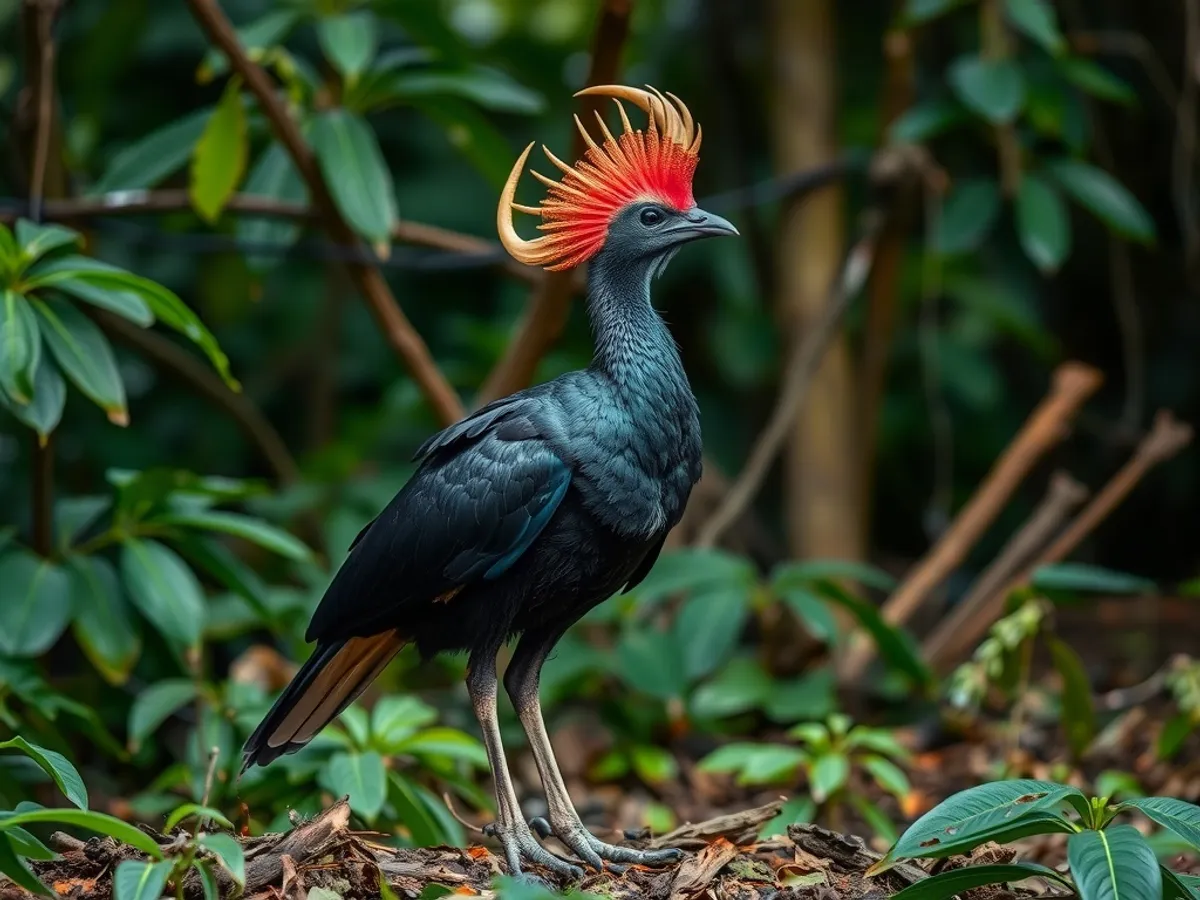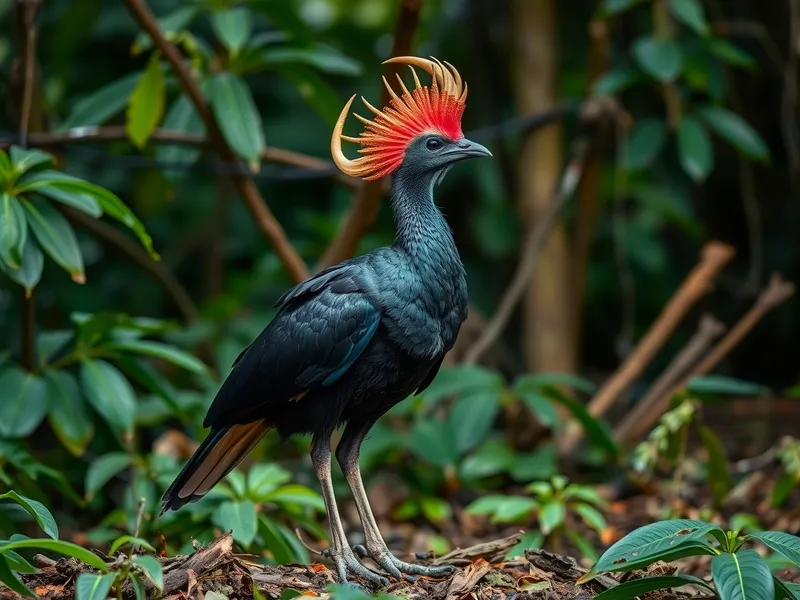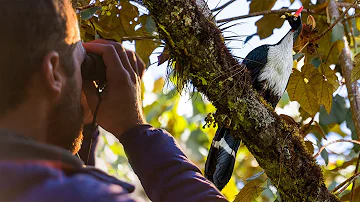
Horned Guan
Oreophasis derbianus

Meet the Horned Guan
The Horned Guan is a striking and rare bird native to the cloud forests of Central America, particularly in southern Mexico and Guatemala. Distinguished by its glossy black plumage, white breast, and a vivid red horn-like casque on its head, this species is truly unique among birds. It spends most of its time high in the forest canopy, feeding on fruits, leaves, and seeds. Due to habitat loss and its naturally limited distribution, the Horned Guan is classified as Endangered.
Classification
Bird
Habitat
Cloud forest
Diet
Herbivore
Lifespan
15-20 years
Conservation
Endangered
Weight
1.4-2.1 kg
📖Fascinating Facts
Cloud Forest Specialist
The Horned Guan exclusively inhabits high-altitude cloud forests, typically between 1,650 and 3,500 meters above sea level.
Unique Appearance
It can be easily identified by the bright red horn-like casque on its head, a feature found in no other bird species.
Fruit Lover
Its diet consists mainly of fruits, but it also consumes leaves, flowers, and seeds, which helps regenerate its forest habitat.
📋Detailed Description
The Horned Guan (Oreophasis derbianus) is a large, arboreal bird measuring 85–95 cm (33–37 in) in length and weighing between 1.4 and 2.1 kg (3.1–4.6 lbs). Its most distinctive feature is the prominent, fleshy, bright red horn or casque, approximately 4–6 cm tall, projecting vertically from the crown of its head—a trait unique among cracids. The plumage is predominantly glossy black with a contrasting white breast, belly, and undertail coverts. The tail is long and broad, with white tips on the outer feathers. The legs and feet are pale red, and the eyes are dark brown. Adapted for life in the upper canopy of montane cloud forests, the Horned Guan has strong legs and feet for grasping branches, and a robust bill suited for processing a variety of plant materials. Its wings are relatively short and rounded, reflecting its preference for climbing and hopping among branches rather than sustained flight. The species is generally solitary or found in pairs, exhibiting secretive and cautious behavior. Its vocalizations include deep booming calls and sharp whistles, which are most often heard at dawn and dusk. The Horned Guan plays a crucial ecological role as a seed disperser in its native habitat.
💡 Did you know?
Despite its turkey-like appearance, the Horned Guan is more closely related to other cracids than to true guans, and it diverged from its relatives over 20 million years ago.
🔬Research & Sources
Wikipedia Summary
The horned guan is an endangered species in an ancient group of birds of the family Cracidae, which are related to the Australasian megapodes or mound builders (Megapodiidae). It is found in Mexico, Guatemala, and possibly Honduras.
Last Modified: 5/13/2025
🎭Behavior & Social Structure
Horned Guans are primarily diurnal and spend most of their time in the mid to upper canopy, rarely descending to the forest floor. Their diet consists mainly of fruits, leaves, buds, and seeds, with occasional ingestion of flowers and invertebrates. Foraging is typically solitary or in pairs, with individuals methodically moving through the canopy to select ripe fruits, particularly from Lauraceae, Ficus, and other native trees. They use their strong bills to pluck and manipulate food items. Social interactions are limited outside the breeding season, and birds maintain large territories, often marked by vocal displays. They are known for their shy and elusive nature, making direct observation challenging. Roosting occurs on high branches, and birds may use the same roost sites repeatedly. During the breeding season, males become more vocal and may perform displays involving the erection of the horn and tail fanning.
👶Reproduction & Life Cycle
Breeding occurs during the dry season, typically from February to June, coinciding with peak fruit availability. The species is monogamous, with pairs forming strong bonds. Courtship involves vocalizations and visual displays, including the raising of the horn and tail spreading. Nests are constructed by the female in the fork of a high tree, usually 10–25 meters above ground, using sticks and lined with leaves. Clutch size is usually one, rarely two, large white eggs. The female incubates the eggs for about 32–34 days, while the male may assist in territory defense. After hatching, the chick is precocial but remains in the nest for several days before following the female through the canopy. Parental care is extended, with the chick dependent on the adults for food and protection for several months.
🛡️Adaptations & Survival
The Horned Guan exhibits several unique adaptations for survival in the cloud forest. Its strong, grasping feet and robust legs facilitate movement through the dense canopy. The bright red horn, a soft, vascularized structure, is believed to play a role in sexual selection and species recognition. The bird's cryptic coloration—dark above and white below—provides camouflage among the dappled light of the forest canopy. Its digestive system is adapted to process fibrous plant material and large seeds, contributing to its role as a key seed disperser. Behavioral adaptations include secretive habits and a preference for inaccessible, steep terrain, reducing predation risk. The species' vocalizations are low-frequency, allowing calls to travel long distances through dense vegetation.
📚Research Sources
🎨Cultural Significance
The Horned Guan holds symbolic value in local cultures, particularly among indigenous communities in the highlands of Chiapas and Guatemala, where it is sometimes regarded as a forest guardian or emblem of pristine wilderness. Its striking appearance has made it a subject of fascination for naturalists and ornithologists since its discovery in the 19th century. There is no significant evidence of widespread traditional use, but its rarity and beauty have led to its depiction in local folklore and ecotourism promotion. The species is considered a flagship for cloud forest conservation efforts in Mesoamerica.
🔬Recent Research & Discoveries
Recent research has focused on the Horned Guan's genetic distinctiveness, confirming its status as the sole member of the subfamily Oreophasinae and highlighting its evolutionary divergence from other cracids. Population surveys using bioacoustic monitoring and camera traps have improved understanding of its distribution and abundance. Studies on its role as a seed disperser underscore its ecological importance for maintaining forest diversity. Conservation programs, including community-based habitat protection and captive breeding initiatives, are ongoing, with some success in increasing local awareness and reducing hunting pressure. The species' response to climate change and habitat fragmentation remains a key area of study, with models predicting further range contraction unless urgent conservation measures are implemented.
🎥Wildlife Videos

30 Most Beautiful Creatures On Earth (Order Galliformes) | Wildlife Documentary | BBTV Official
In the heart of the world's most remote forests and rugged highlands, where mist lingers over ancient trees and the wilderness ...
BBTV Official

Saguaro - The Unexpected Beauty of America's Forgotten National Park | Free Documentary Nature
Saguaro - The Unexpected Beauty of America's Forgotten National Park | Wildlife Documentary Watch 'Yosemite - America's Most ...
Free Documentary - Nature

Creatures Of The Volcano
A million years ago, Italy was shaped by violent volcanic activity that created mountains and destroyed valleys in a lifeless world.
All Out Wildlife

Cloud Forest Enigmas (Horned Guan, Guatemala) | #gobirdingvlog 5 | Birding Vlog
gobirdingvlog | Leander Khil's Vlog on Birds and Birdwatching Episode 5: CLOUD FOREST ENIGMAS feat. Horned Guan Filmed ...
Leander Khil

Owl's Nature, Birds 2018 HD Documentary
Owl's Nature, Birds 2018 HD Documentary.
Roberto Channel

Horned guan (Oreophasis derbianus) Guatemala
Do you want to watch this bird #hornedguan? Well, i invite you to come and let's go to looking for this amaizing emdemic regional ...
Guatemalan Birding Tours
🌍Habitat Information
The Horned Guan typically inhabits Cloud forest environments. Horned Guans have adapted to their environments with specialized features and behaviors.
Primary Habitat:
Cloud forest
More detailed habitat information will be available soon.
🛡️Conservation Status
The Horned Guan is currently classified as Endangered. Conservation efforts are crucial for preserving this species for future generations.
Common Threats:
- 🏠Habitat loss and fragmentation
- 🌡️Climate change impacts
- 🎯Hunting and poaching
- 🏭Human-wildlife conflict
⚠️Threats & Conservation Challenges
The Horned Guan faces severe threats from habitat loss due to deforestation, agricultural expansion, and logging in its limited range. Cloud forests, its primary habitat, are highly fragmented and continue to decline in extent and quality. Hunting for food and, historically, for ornamental purposes has also contributed to population declines. The species' naturally low reproductive rate and specialized habitat requirements make it particularly vulnerable to environmental changes. Current population estimates suggest fewer than 1,000 mature individuals remain, with populations fragmented and declining. Conservation challenges include enforcing protected area boundaries, promoting habitat restoration, and mitigating human encroachment. Climate change poses an additional threat by altering cloud forest microclimates and plant phenology.
🔬Scientific Classification
Scientific Name
Oreophasis derbianus
Classification Hierarchy
🔍 About Taxonomic Classification
Taxonomic classification is a hierarchical system used by scientists to classify and organize living organisms based on shared characteristics and evolutionary relationships.
The system moves from broad categories (Kingdom) to increasingly specific ones, with each animal's scientific name typically consisting of its Genus and species.
📝Community Notes
Share your observations and insights about the Horned Guan with our community of wildlife enthusiasts.
Join Our Community
Sign in to share your observations and connect with fellow wildlife enthusiasts.
Sign In to ContributeNo community notes yet
Be the first to share your observations about the Horned Guan!
Explore Horned Guan
Select a tab above to learn more about this amazing animal.
📸Photo Gallery
No photos available for this animal yet.
🌟Discover More Wildlife
Continue your journey of discovery with more fascinating animals from our database
